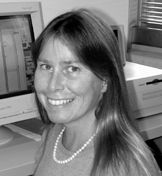 REGIONAL GROUPS REGIONAL GROUPS
by Suzanne Clancy
Georgia Area
Members of the newly revived Georgia Area Science Writers
Association (GASWA) learned about the multimillion dollar bioinformatics
initiative being led by the Georgia Research Alliance and received
an overview of how DNA microarray technology is accelerating
genetic research. The speakers were C. Michael Cassidy, president
of the Georgia Research Alliance, and Dr. Scott Hemby, director
of the DNA Microarray Facility at Emory University. The September
meeting was held at Georgia Tech's new Institute for Bioengineering
and Bioscience, and attendees included Atlanta-area freelancers
and representatives from CNN, the Atlanta Business Chronicle,
WebMD, Emory University, the University of Georgia, and Georgia
Tech. The Georgia Research Alliance is a public/private initiative
that has invested nearly $300 million in research facilities
and support for eminent scholars at Georgia's six research universities.
Northern California
In July, the Northern California Science Writers Association
organized a walking tour of the Presidio, a sprawling former
military base that is now a national park within the San Francisco
city limits. Participants learned about the Presidio's history,
dating back to a settlement of Ohlone Indians long before the
Spanish arrived in 1776 to set up a fort. Members also toured
Crissy Field, a major wetlands restoration project on the site
of an old airfield. The day concluded with a hike into the hills
of the Presidio, through forests and grasslands where native
plants are being restored and along paths once used by soldiers
heading into town for an evening of fun. In August, NCSWA sponsored
a three-day multimedia reporting workshop for journalists. (See page 6 for story by presenter Jane
Stevens.) Then in September, NCSWA members enjoyed a behind-the-scenes
view of the just-opened Chabot Space and Science Center, an innovative
teaching and learning center in the Oakland hills. Members took
in a planetarium show, created with Chabot's state-of-the-art
star projector, and toured labs intended for use by school groups.
To the consternation of our guide, NCSWA members played with
glove boxes, remote-controlled arms, and computer monitors in
the Challenger Learning Center, which uses simulated space missions
to reach students (and, apparently, visiting science writers).
Unfortunately, fog prevented any observing through the 20-inch
refracting telescope.
Washington, DC
Washington, DC area science writers had a busy summer schedule.
In July, DCSWA members joined the American Medical Writers Association's
Mid-Atlantic chapter for an exclusive, behind-the-scenes tour
of the National Aquarium, in Baltimore. For this family-oriented
event, aquarium education staff explained the intricacies of
caring for 10,000 sea creatures, from anemones to zooplankton.
The tour included a special program for younger children, with
live animals, storytelling, and hands-on demonstrations. Several
DCSWAns spent an August Saturday canoeing in the marshes of Mataponi
Creek, a small tidal arm of Maryland's Patuxent River. Leading
the day-long tour was John Page Williams, a senior naturalist
with the Chesapeake Bay Foundation. The lush Mataponi is a bright
spot in the nutrient-plagued watershed, according to Williams.
He netted several different species of fish and a red-footed
turtle. Williams also pointed out the resurgence of some underwater
grasses, a sign that nutrients in the Chesapeake watershed are
declining to more healthy levels. DCSWAns also gathered for a
post-Labor-Day happy hour in downtown's Dupont Circle.
Science Writers in New York
In May, SWINY members heard Marianne Legato, MD, FACP, founder
and director of the Partnership for Women's Health at Columbia
University, and her colleagues discuss the rapidly growing field
of gender-specific medicine, which seeks to understand why certain
diseases may be more prevalent or more severe in one sex than
the other with an eye to better diagnosis, treatment, and prevention.
Thanks to the summer of 1999, New York Metro area dwellers feared
summer 2000 might hearken the return of the West Nile virus.
SWINY members gathered in June to learn more about the virus
and the quality of last year's reporting on it from Dr. Durland
Fish, associate professor in the Department of Epidemiology and
Public Health at Yale University. In September, SWINY visited
the Brookhaven National Lab. Tour offerings included the Relativistic
Heavy Ion Collider, the world's newest and largest particle accelerator
for nuclear physics research; Positron Emission Tomography measurement
of metabolism in the brain; and the National Synchrotron Light
Source, which produces some of the brightest beams of ultraviolet
and X-ray light that may be used to "see" the structures
of proteins and how they interact with other molecules. In October,
pollmeister Robert J. Blendon, ScD, director of the Harvard University
Program on Public Opinion and Health and Social Policy, discussed
the art and science of measuring opinion. To learn what's in
store for SWINY or to join, visit www.nasw.org/users/swiny/.
Suzanne Clancy is science writer at The Salk Institute,
in La Jolla, CA. Send information on regional meetings and events
to clancy@salk.edu.
Return
to NASW homepage.
- Return
to NASW Members' Lobby.
- Return
to ScienceWriters Newsletter homepage.
|

